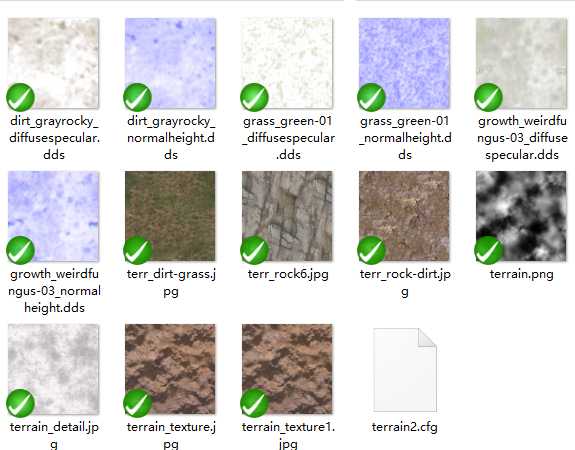标签:
需要用到的外部图片资源:

在ogre调用时需要多用到的几个外部dll:
OgreTerrain_d.dll
需要添加头文件
#include "Ogre\Ogre.h"
#include "Ogre\OgreFileSystemLayer.h"
#include "Ogre\OgreTerrain.h"
#include "Ogre\OgreTerrainGroup.h"
#include "Ogre\OgreTerrainQuadTreeNode.h"
#include "Ogre\OgreTerrainMaterialGeneratorA.h"
#include "Ogre\OgreTerrainPaging.h"
定义类初始化需要的结构体
struct CrisTerrainInitStruct
{
CrisTerrainInitStruct():m_scenemanager(NULL),fMaxHoriz(1000),fMinHoriz(0),sMapFilename(""),sElevationFilename(""),fMapSize(TERRAIN_WORLD_SIZE)
{
fInputScale = fMaxHoriz - fMinHoriz;
}
SceneManager* m_scenemanager;
String sMapFilename; //地图卫星图片
String sElevationFilename;//高程图
Real fMinHoriz;//最低点
Real fMaxHoriz;//最高点
Real fMapSize;//地形边长
Real fInputScale; //地形高低差 对比像素的0~1 .可以不需要设置
//位置放在000点,
};
类的外部接口
void Init(CrisTerrainInitStruct* sInitData);
实现的一些重要步骤:
第一步 创建地形全局配置 TerrainGlobalOptions
mTerrainGlobals = OGRE_NEW TerrainGlobalOptions();
//TerrainGlobalOptions是一个类,定义了地形块的一些全局变量和默认值,需要的话我们可以改变他的变量参数,我们后面再做改变。
第二步 创建地形分组Ogre::TerrainGroup
//实例化一个TerrainGroup对象
mTerrainGroup = OGRE_NEW TerrainGroup(mSceneMgr, Terrain::ALIGN_X_Z, TERRAIN_SIZE, m_sInitData->fMapSize);
第三步 配置地图块参数 configureTerrainDefaults
configureTerrainDefaults();
第四步 创建地形分块
//defineTerrain方法首先要指定该块地形在地形分组中的索引位置,然后第三个参数必须指定高度数据,用灰度图创建山地地形
for (long x = TERRAIN_PAGE_MIN_X; x <= TERRAIN_PAGE_MAX_X; ++x)
for (long y = TERRAIN_PAGE_MIN_Y; y <= TERRAIN_PAGE_MAX_Y; ++y)
defineTerrain(x, y, blankTerrain);
下面是我的代码:
头文件:
#pragma once
#define DebugTerrain
#include "Ogre\Ogre.h"
#include "Ogre\OgreFileSystemLayer.h"
#include "CrisConfig\CrisConfig.h"
#include "Ogre\OgreTerrain.h"
#include "Ogre\OgreTerrainGroup.h"
#include "Ogre\OgreTerrainQuadTreeNode.h"
#include "Ogre\OgreTerrainMaterialGeneratorA.h"
#include "Ogre\OgreTerrainPaging.h"
//分页多少
#define TERRAIN_PAGE_MIN_X 0
#define TERRAIN_PAGE_MIN_Y 0
#define TERRAIN_PAGE_MAX_X 0
#define TERRAIN_PAGE_MAX_Y 0
#define TERRAIN_FILE_PREFIX String("testTerrain")
#define TERRAIN_FILE_SUFFIX String("dat")
#define TERRAIN_WORLD_SIZE 1200.0f
#define TERRAIN_SIZE 513
using namespace Ogre;
struct CrisTerrainInitStruct
{
CrisTerrainInitStruct():m_scenemanager(NULL),fMaxHoriz(1000),fMinHoriz(0),sMapFilename(""),sElevationFilename(""),fMapSize(TERRAIN_WORLD_SIZE)
{
fInputScale = fMaxHoriz - fMinHoriz;
}
SceneManager* m_scenemanager;
String sMapFilename; //地图卫星图片
String sElevationFilename;//高程图
Real fMinHoriz;//最低点
Real fMaxHoriz;//最高点
Real fMapSize;//地形边长
Real fInputScale; //地形高低差 对比像素的0~1 .可以不需要设置
//位置放在000点,
};
class CrisTerrain
{
public:
CrisTerrain();
~CrisTerrain();
void Init(CrisTerrainInitStruct* sInitData);
//void setTerrainImage(const Ogre::String& szCfgFilename = "terrain_texture.jpg");
protected:
TerrainGlobalOptions* mTerrainGlobals;
TerrainGroup* mTerrainGroup;
TerrainPaging* mTerrainPaging;
PageManager* mPageManager;
void testOption();//为了小样例测试加载的,在大工程中可以直接不用
private:
CrisTerrainInitStruct* m_sInitData;
void loadConfigFile(const Ogre::String& szCfgFilename = "");
Ogre::String m_szConfigFileName;
CCrisConfigManager m_hConfigMgr;
bool mFly;
Real mFallVelocity;
Real mBrushSizeTerrainSpace;
Real mHeightUpdateCountDown;
Real mHeightUpdateRate;
Vector3 mTerrainPos;
bool mTerrainsImported;
SceneManager* mSceneMgr;
/** @brief 实例化地形 */
void setupContent();
/** @brief 实例化地形参数 */
void configureTerrainDefaults();
void initBlendMaps(Terrain* terrain);
void defineTerrain(long x, long y, bool flat = false);
void getTerrainImage(bool flipX, bool flipY, Image& img);
};
实现文件:
#include "Terrain.h"
CrisTerrain::CrisTerrain(): mTerrainGroup(0)
, mTerrainPaging(0)
, mPageManager(0)
, mFallVelocity(0)
, mBrushSizeTerrainSpace(0.02)
, mHeightUpdateCountDown(0)
, mTerrainPos(0,0,0)
, mTerrainsImported(false)
{
}
CrisTerrain::~CrisTerrain()
{
}
void CrisTerrain::Init(CrisTerrainInitStruct* sInitData)
{
mSceneMgr = sInitData->m_scenemanager;
m_sInitData = sInitData;
setupContent();
//loadConfigFile("terrain.cfg");
}
void CrisTerrain::loadConfigFile(const String& szFilename)
{
if(!szFilename.empty())
m_szConfigFileName = szFilename;
else
return;
//m_hConfigMgr.LoadFromResourceSystem(m_szConfigFileName);
//String worldTexture = m_hConfigMgr.GetValueString("Ter", "WorldTexture", "testter.jpg");
//OutputDebugString(worldTexture.c_str());
}
//void CrisTerrain::setTerrainImage(const Ogre::String& szCfgFilename)
//{
// Terrain::ImportData& defaultimp = mTerrainGroup->getDefaultImportSettings();
// defaultimp.terrainSize = TERRAIN_SIZE;//不太了解,调试中,这个值越小,地图边缘锯齿现象越严重,太小的话,运行起来程序会跑死、出错
// defaultimp.worldSize = m_sInitData->fMapSize;//假设为a,那么地图大小为 a x a
// defaultimp.inputScale = 60;//决定地图最大落差(高度),即位图中白色和黑色部分的高度差
// defaultimp.minBatchSize = 33;
// defaultimp.maxBatchSize = 65;
// // textures
// defaultimp.layerList.resize(3);//这里设置了3层纹理,DDS为一种高级的纹理模式,DirectDrawSurface,觉得难以理解的话
////可以理解为一种特殊的.jpg图片模式,但是用DDS质材的话可以接收并显示地形阴影,用JPG就显示不出来,而且据我调试观
////察发现,第一个.dds质材是用来显示纹理图形,第二个.dds才是用来接收和显示阴影的
//
// defaultimp.layerList[0].worldSize = 1;//这个值关系到此贴图的细致程度,太大的话图片被拉伸得很大,看起来模糊
// defaultimp.layerList[0].textureNames.push_back(szCfgFilename);
// defaultimp.layerList[0].textureNames.push_back(szCfgFilename);
// defaultimp.layerList[1].worldSize = 1;
// defaultimp.layerList[1].textureNames.push_back(szCfgFilename);
// defaultimp.layerList[1].textureNames.push_back(szCfgFilename);
// defaultimp.layerList[2].worldSize = 2;
// defaultimp.layerList[2].textureNames.push_back(szCfgFilename);
// defaultimp.layerList[2].textureNames.push_back(szCfgFilename);
//
// mTerrainGroup->loadAllTerrains(true);
//
// if (mTerrainsImported)
// {
// TerrainGroup::TerrainIterator ti = mTerrainGroup->getTerrainIterator();
// while(ti.hasMoreElements())
// {
// Terrain* t = ti.getNext()->instance;
// initBlendMaps(t);
// }
// }
//
// mTerrainGroup->freeTemporaryResources();
//}
void CrisTerrain::testOption()
{
//mEditMarker = mSceneMgr->createEntity("editMarker", "sphere.mesh");
//mEditNode = mSceneMgr->getRootSceneNode()->createChildSceneNode();
//mEditNode->attachObject(mEditMarker);
//mEditNode->setScale(0.05, 0.05, 0.05);
Ogre::FileSystemLayer* mFSLayer = OGRE_NEW_T(Ogre::FileSystemLayer, Ogre::MEMCATEGORY_GENERAL)(OGRE_VERSION_NAME);
ResourceGroupManager::getSingleton().createResourceGroup("Terrain");
ResourceGroupManager::getSingleton().addResourceLocation(mFSLayer->getWritablePath(""), "FileSystem", "Terrain", false, false);
MaterialManager::getSingleton().setDefaultTextureFiltering(TFO_ANISOTROPIC);
MaterialManager::getSingleton().setDefaultAnisotropy(7);
//mSceneMgr->setFog(FOG_LINEAR, ColourValue(0.7, 0.7, 0.8), 0, 1000, 2500);
LogManager::getSingleton().setLogDetail(LL_BOREME);
mSceneMgr->setAmbientLight(ColourValue(0.6, 0.6, 0.6));
//// create a few entities on the terrain
//Entity* e = mSceneMgr->createEntity("tudorhouse.mesh");
//Vector3 entPos(mTerrainPos.x + 2043, 0, mTerrainPos.z + 1715);
//Quaternion rot;
//entPos.y = mTerrainGroup->getHeightAtWorldPosition(entPos) + 65.5 + mTerrainPos.y;
//rot.FromAngleAxis(Degree(Math::RangeRandom(-180, 180)), Vector3::UNIT_Y);
//SceneNode* sn = mSceneMgr->getRootSceneNode()->createChildSceneNode(entPos, rot);
//sn->setScale(Vector3(0.12, 0.12, 0.12));
//sn->attachObject(e);
//mSceneMgr->setSkyBox(true, "Examples/CloudyNoonSkyBox");
}
void CrisTerrain::setupContent()
{
bool blankTerrain = false;
//blankTerrain = true;
mTerrainGlobals = OGRE_NEW TerrainGlobalOptions();
//TerrainGlobalOptions是一个类,定义了地形块的一些全局变量和默认值,需要的话我们可以改变他的变量参数,我们后面再做改变。
#ifdef DebugTerrain
testOption();
#endif
//创建地形分组Ogre::TerrainGroup
/*实例化一个TerrainGroup对象
参数1:为他指定场管理器、
参数2:地形的平铺方向,平铺方向一般采用ALIGN_X_Z,也就是采用Y作为高度
参数3:unit16 TERRAINSIZE=2~n+1,比如512+1=513,不符合公式的可能会导致地图显示异常,表示“The
size of each terrain down one edge in vertices (2^n+1)”楼主只能理解意思,不能完全正确
表达其中的专有名词,实际调试中,这个参数影响地图边缘的锯齿度,越小锯齿越明显,取值太小
的话,运行会错误;
参数4:Real TERRAINWORLDSIZE,地图大小,表示地图正方形的边长)
*/
mTerrainGroup = OGRE_NEW TerrainGroup(mSceneMgr, Terrain::ALIGN_X_Z, TERRAIN_SIZE, m_sInitData->fMapSize);
//定义命名前缀
mTerrainGroup->setFilenameConvention(TERRAIN_FILE_PREFIX, TERRAIN_FILE_SUFFIX);
//设置了该地形组的起始位置,在以后创建的地形块中均采用此位置作为相对位置
mTerrainGroup->setOrigin(mTerrainPos);
mTerrainGroup->setResourceGroup("Terrain");
//配置地图块参数 configureTerrainDefaults
configureTerrainDefaults();
for (long x = TERRAIN_PAGE_MIN_X; x <= TERRAIN_PAGE_MAX_X; ++x)
for (long y = TERRAIN_PAGE_MIN_Y; y <= TERRAIN_PAGE_MAX_Y; ++y)
defineTerrain(x, y, blankTerrain);
// 开始前加载好
mTerrainGroup->loadAllTerrains(true);
if (mTerrainsImported)
{
TerrainGroup::TerrainIterator ti = mTerrainGroup->getTerrainIterator();
while(ti.hasMoreElements())
{
Terrain* t = ti.getNext()->instance;
initBlendMaps(t);
}
}
mTerrainGroup->freeTemporaryResources();
}
void CrisTerrain::getTerrainImage(bool flipX, bool flipY, Image& img)
{
img.load(m_sInitData->sElevationFilename, ResourceGroupManager::DEFAULT_RESOURCE_GROUP_NAME);
if (flipX)
img.flipAroundY();
if (flipY)
img.flipAroundX();
}
void CrisTerrain::defineTerrain(long x, long y, bool flat)
{
// if a file is available, use it
// if not, generate file from import
// Usually in a real project you‘ll know whether the compact terrain data is
// available or not; I‘m doing it this way to save distribution size
if (flat)
{
mTerrainGroup->defineTerrain(x, y, 0.0f);
}
else
{
String filename = mTerrainGroup->generateFilename(x, y);
if (ResourceGroupManager::getSingleton().resourceExists(mTerrainGroup->getResourceGroup(), filename))
{
mTerrainGroup->defineTerrain(x, y);
}
else
{
Image img;
getTerrainImage(x % 2 != 0, y % 2 != 0, img);
mTerrainGroup->defineTerrain(x, y, &img);
mTerrainsImported = true;
}
}
}
void CrisTerrain::configureTerrainDefaults()
{
// Configure global
mTerrainGlobals->setMaxPixelError(8);
// testing composite map
mTerrainGlobals->setCompositeMapDistance(3000);//距离镜头超过3000部分使用地图合成(CompositeMap)模式表现
//mTerrainGlobals->setUseRayBoxDistanceCalculation(true);
//mTerrainGlobals->getDefaultMaterialGenerator()->setDebugLevel(1);
//mTerrainGlobals->setLightMapSize(256);
// Configure default import settings for if we use imported image
Terrain::ImportData& defaultimp = mTerrainGroup->getDefaultImportSettings();
defaultimp.terrainSize = TERRAIN_SIZE;//不太了解,调试中,这个值越小,地图边缘锯齿现象越严重,太小的话,运行起来程序会跑死、出错
defaultimp.worldSize = m_sInitData->fMapSize;//假设为a,那么地图大小为 a x a
defaultimp.inputScale = m_sInitData->fInputScale;//决定地图最大落差(高度),即位图中白色和黑色部分的高度差
defaultimp.minBatchSize = 33;
defaultimp.maxBatchSize = 65;
// textures
defaultimp.layerList.resize(3);//这里设置了3层纹理,DDS为一种高级的纹理模式,DirectDrawSurface,觉得难以理解的话
//可以理解为一种特殊的.jpg图片模式,但是用DDS质材的话可以接收并显示地形阴影,用JPG就显示不出来,而且据我调试观
//察发现,第一个.dds质材是用来显示纹理图形,第二个.dds才是用来接收和显示阴影的
defaultimp.layerList[0].worldSize = m_sInitData->fMapSize;//这个值关系到此贴图的细致程度,太大的话图片被拉伸得很大,看起来模糊
defaultimp.layerList[0].textureNames.push_back(m_sInitData->sMapFilename);
defaultimp.layerList[0].textureNames.push_back(m_sInitData->sMapFilename);
defaultimp.layerList[1].worldSize = m_sInitData->fMapSize;
defaultimp.layerList[1].textureNames.push_back("white2.dds");
defaultimp.layerList[1].textureNames.push_back("white2.dds");
defaultimp.layerList[2].worldSize = m_sInitData->fMapSize;
defaultimp.layerList[2].textureNames.push_back("white2.dds");
defaultimp.layerList[2].textureNames.push_back("white2.dds");
//defaultimp.layerList[0].worldSize = 100;//这个值关系到此贴图的细致程度,太大的话图片被拉伸得很大,看起来模糊
//defaultimp.layerList[0].textureNames.push_back("dirt_grayrocky_diffusespecular.dds");
//defaultimp.layerList[0].textureNames.push_back("dirt_grayrocky_normalheight.dds");
//defaultimp.layerList[1].worldSize = 30;
//defaultimp.layerList[1].textureNames.push_back("grass_green-01_diffusespecular.dds");
//defaultimp.layerList[1].textureNames.push_back("grass_green-01_normalheight.dds");
//defaultimp.layerList[2].worldSize = 100;
//defaultimp.layerList[2].textureNames.push_back("growth_weirdfungus-03_diffusespecular.dds");
//defaultimp.layerList[2].textureNames.push_back("growth_weirdfungus-03_normalheight.dds");
}
void CrisTerrain::initBlendMaps(Terrain* terrain)
{
TerrainLayerBlendMap* blendMap0 = terrain->getLayerBlendMap(1);
TerrainLayerBlendMap* blendMap1 = terrain->getLayerBlendMap(2);
Real minHeight0 = 70;
Real fadeDist0 = 40;
Real minHeight1 = 70;
Real fadeDist1 = 15;
float* pBlend1 = blendMap1->getBlendPointer();
for (Ogre::uint16 y = 0; y < terrain->getLayerBlendMapSize(); ++y)
{
for (Ogre::uint16 x = 0; x < terrain->getLayerBlendMapSize(); ++x)
{
Real tx, ty;
blendMap0->convertImageToTerrainSpace(x, y, &tx, &ty);
Real height = terrain->getHeightAtTerrainPosition(tx, ty);
Real val = (height - minHeight0) / fadeDist0;
Math::Clamp(val, (Real)0, (Real)1);
val = (height - minHeight1) / fadeDist1;
val = Math::Clamp(val, (Real)0, (Real)1);
*pBlend1++ = val;
}
}
blendMap0->dirty();
blendMap1->dirty();
//blendMap0->loadImage("blendmap1.png", ResourceGroupManager::DEFAULT_RESOURCE_GROUP_NAME);
blendMap0->update();
blendMap1->update();
// set up a colour map
/*
if (!terrain->getGlobalColourMapEnabled())
{
terrain->setGlobalColourMapEnabled(true);
Image colourMap;
colourMap.load("testcolourmap.jpg", ResourceGroupManager::DEFAULT_RESOURCE_GROUP_NAME);
terrain->getGlobalColourMap()->loadImage(colourMap);
}
*/
}
[Ogre][地形][原创]基于OgreTerrain的地形实现
标签:
原文地址:http://www.cnblogs.com/lyggqm/p/5507689.html